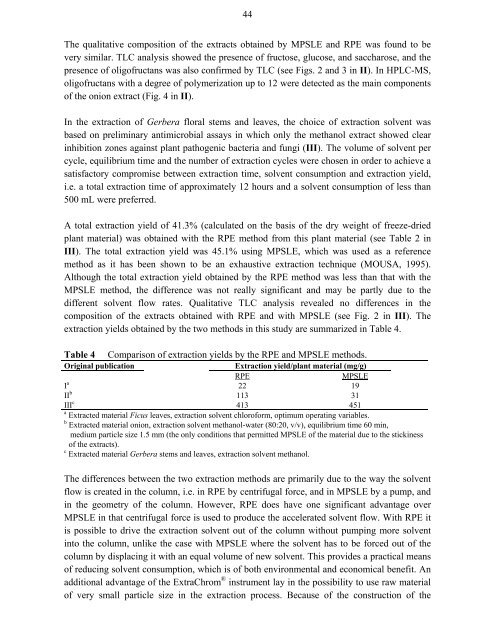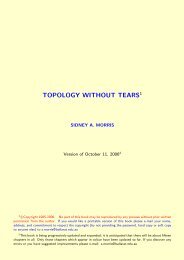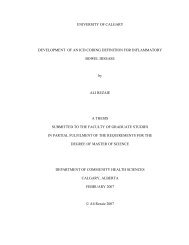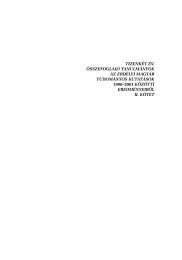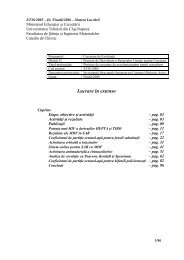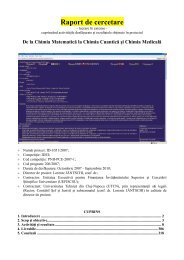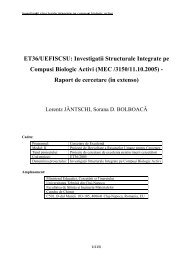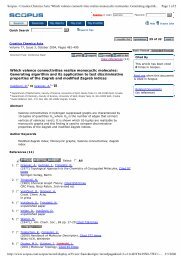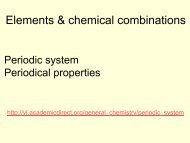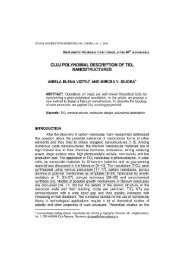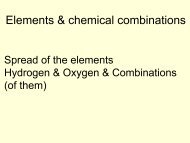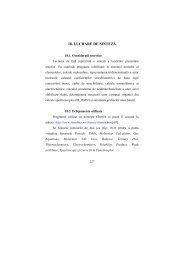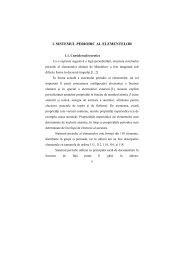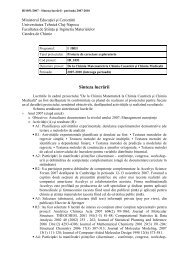Extraction and Planar Chromatographic Separation Techniques in the
Extraction and Planar Chromatographic Separation Techniques in the
Extraction and Planar Chromatographic Separation Techniques in the
You also want an ePaper? Increase the reach of your titles
YUMPU automatically turns print PDFs into web optimized ePapers that Google loves.
44<br />
The qualitative composition of <strong>the</strong> extracts obta<strong>in</strong>ed by MPSLE <strong>and</strong> RPE was found to be<br />
very similar. TLC analysis showed <strong>the</strong> presence of fructose, glucose, <strong>and</strong> saccharose, <strong>and</strong> <strong>the</strong><br />
presence of oligofructans was also confirmed by TLC (see Figs. 2 <strong>and</strong> 3 <strong>in</strong> II). In HPLC-MS,<br />
oligofructans with a degree of polymerization up to 12 were detected as <strong>the</strong> ma<strong>in</strong> components<br />
of <strong>the</strong> onion extract (Fig. 4 <strong>in</strong> II).<br />
In <strong>the</strong> extraction of Gerbera floral stems <strong>and</strong> leaves, <strong>the</strong> choice of extraction solvent was<br />
based on prelim<strong>in</strong>ary antimicrobial assays <strong>in</strong> which only <strong>the</strong> methanol extract showed clear<br />
<strong>in</strong>hibition zones aga<strong>in</strong>st plant pathogenic bacteria <strong>and</strong> fungi (III). The volume of solvent per<br />
cycle, equilibrium time <strong>and</strong> <strong>the</strong> number of extraction cycles were chosen <strong>in</strong> order to achieve a<br />
satisfactory compromise between extraction time, solvent consumption <strong>and</strong> extraction yield,<br />
i.e. a total extraction time of approximately 12 hours <strong>and</strong> a solvent consumption of less than<br />
500 mL were preferred.<br />
A total extraction yield of 41.3% (calculated on <strong>the</strong> basis of <strong>the</strong> dry weight of freeze-dried<br />
plant material) was obta<strong>in</strong>ed with <strong>the</strong> RPE method from this plant material (see Table 2 <strong>in</strong><br />
III). The total extraction yield was 45.1% us<strong>in</strong>g MPSLE, which was used as a reference<br />
method as it has been shown to be an exhaustive extraction technique (MOUSA, 1995).<br />
Although <strong>the</strong> total extraction yield obta<strong>in</strong>ed by <strong>the</strong> RPE method was less than that with <strong>the</strong><br />
MPSLE method, <strong>the</strong> difference was not really significant <strong>and</strong> may be partly due to <strong>the</strong><br />
different solvent flow rates. Qualitative TLC analysis revealed no differences <strong>in</strong> <strong>the</strong><br />
composition of <strong>the</strong> extracts obta<strong>in</strong>ed with RPE <strong>and</strong> with MPSLE (see Fig. 2 <strong>in</strong> III). The<br />
extraction yields obta<strong>in</strong>ed by <strong>the</strong> two methods <strong>in</strong> this study are summarized <strong>in</strong> Table 4.<br />
Table 4 Comparison of extraction yields by <strong>the</strong> RPE <strong>and</strong> MPSLE methods.<br />
Orig<strong>in</strong>al publication <strong>Extraction</strong> yield/plant material (mg/g)<br />
RPE MPSLE<br />
I a<br />
22 19<br />
113 31<br />
II b<br />
III c<br />
413 451<br />
a Extracted material Ficus leaves, extraction solvent chloroform, optimum operat<strong>in</strong>g variables.<br />
b Extracted material onion, extraction solvent methanol-water (80:20, v/v), equilibrium time 60 m<strong>in</strong>,<br />
medium particle size 1.5 mm (<strong>the</strong> only conditions that permitted MPSLE of <strong>the</strong> material due to <strong>the</strong> stick<strong>in</strong>ess<br />
of <strong>the</strong> extracts).<br />
c Extracted material Gerbera stems <strong>and</strong> leaves, extraction solvent methanol.<br />
The differences between <strong>the</strong> two extraction methods are primarily due to <strong>the</strong> way <strong>the</strong> solvent<br />
flow is created <strong>in</strong> <strong>the</strong> column, i.e. <strong>in</strong> RPE by centrifugal force, <strong>and</strong> <strong>in</strong> MPSLE by a pump, <strong>and</strong><br />
<strong>in</strong> <strong>the</strong> geometry of <strong>the</strong> column. However, RPE does have one significant advantage over<br />
MPSLE <strong>in</strong> that centrifugal force is used to produce <strong>the</strong> accelerated solvent flow. With RPE it<br />
is possible to drive <strong>the</strong> extraction solvent out of <strong>the</strong> column without pump<strong>in</strong>g more solvent<br />
<strong>in</strong>to <strong>the</strong> column, unlike <strong>the</strong> case with MPSLE where <strong>the</strong> solvent has to be forced out of <strong>the</strong><br />
column by displac<strong>in</strong>g it with an equal volume of new solvent. This provides a practical means<br />
of reduc<strong>in</strong>g solvent consumption, which is of both environmental <strong>and</strong> economical benefit. An<br />
additional advantage of <strong>the</strong> ExtraChrom ® <strong>in</strong>strument lay <strong>in</strong> <strong>the</strong> possibility to use raw material<br />
of very small particle size <strong>in</strong> <strong>the</strong> extraction process. Because of <strong>the</strong> construction of <strong>the</strong>


